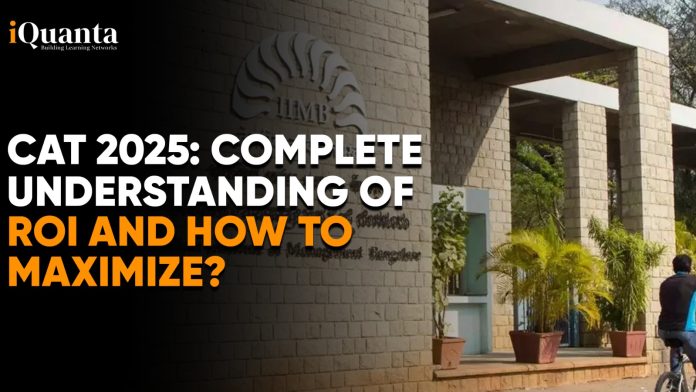Return on Investment, also known as ROI, shows how much money you make compared to the money you spend. It’s a way to check if an investment was worth it. The higher the ROI, the better the returns.
In an MBA, your investment includes tuition fees, living expenses, and other costs, while your returns come from your salary package, network, exposure, learning environment, skills, and overall experiences.
Understanding ROI in an MBA is crucial before admission. Every aspirant should know what it means and how to maximize it for the best returns.

What is ROI in an MBA?
From the above, we understand that ROI is a key factor in selecting the right MBA college. First and foremost, it helps you evaluate both financial and non-financial benefits after graduation. Many students overlook this and make poor decisions.
Second, ROI is especially important for those who didn’t score well in CAT but still want to pursue an MBA. Understanding this concept helps them choose a college that aligns with their financial and career goals.
Some aspirants are not willing to invest over ₹10 lakh, while others hesitate to take loans. Some prefer not to spend another year preparing and go for the best available college to graduate and start earning sooner, prioritizing time over money.
Therefore, we will explore this concept by evaluating both the money you invest and the financial and non-financial benefits you gain after an MBA.
Evaluating the Money You Spend on an MBA
College Fees
The most important and covering the largest portion of your expenditure. College fees include 2-year MBA program tuition fees, admission fees, hostel fees, books fees, library fees, and security deposit.
Living Expenses
This category includes expenses for room decoration, room rent, college travel, and other costs related to maintaining a comfortable lifestyle, especially for those without hostel facilities.
Miscellaneous Expenses
The next category is essential for every MBA student. It includes fees for college fests, fines, placement assistance, dining out, trips with friends, and other miscellaneous expenses.

Evaluating the Benefits You Get from an MBA
Financial Benefits
Financial benefits mainly include your salary after MBA placement. Additionally, they cover scholarships, cash rewards from college and competitions, internship stipends, and earnings from side hustles like freelancing or running a business, especially if boosted by your MBA.
Non-Financial Benefits
The most crucial benefit after the job placement is the overall experience you gain during your MBA. This includes the network you build, the exposure you gain, the learning environment you grow in, the skills you develop, and the overall experiences you gain over two years.
How to measure the overall impact and ROI of an MBA?
Now that you understand the investment and returns of an MBA, the choice of college depends on your priorities, as many factors are subjective. For example, some choose FMS over IIM Ahmedabad due to lower fees and higher financial returns. Ultimately, your MBA journey should align with your career aspirations and personal goals in life.
When most of the aspirants measure the MBA ROI based on fees and the average CTC, we have added a list of MBA colleges with the best financial returns.
Join the Largest CAT Preparation Community in India

Best ROI MBA Colleges
| MBA Colleges | Fees (Lakhs) | Average CTC (Lakhs) |
| FMS Delhi | 2 | 34.1 |
| TISS Mumbai | 2.5 | 27.22 |
| IIT Bombay | 14 | 28.88 |
| JBIMS Mumbai | 6 | 27.6 |
| IIT Delhi | 10 | 25.8 |
| IIT Kharagpur | 11.5 | 22.13 |
| IIT Madras | 11 | 20.19 |
| DFS Delhi | 48K | 14.55 |
| DSE Delhi | 48K | 14.50 |
| SIMSREE Mumbai | 1.5 | 12.30 |


